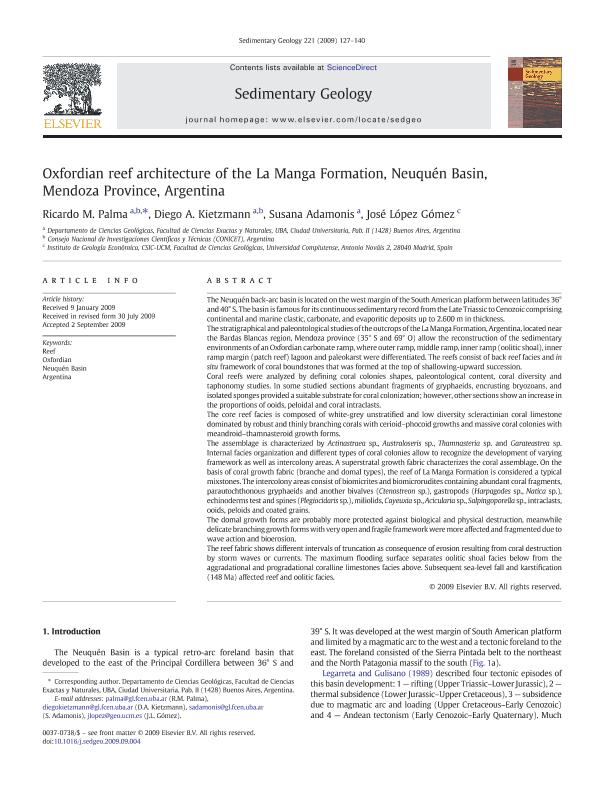Artículo
Oxfordian reef architecture of the La Manga Formation, Neuquén Basin, Mendoza Province, Argentina
Fecha de publicación:
11/2009
Editorial:
Elsevier Science
Revista:
Sedimentary Geology
ISSN:
0037-0738
Idioma:
Inglés
Tipo de recurso:
Artículo publicado
Clasificación temática:
Resumen
The Neuquén back-arc basin is located on the west margin of the South American platform between latitudes 36° and 40° S. The basin is famous for its continuous sedimentary record from the Late Triassic to Cenozoic comprising continental and marine clastic, carbonate, and evaporitic deposits up to 2.600 m in thickness. The stratigraphical and paleontological studies of the outcrops of the La Manga Formation, Argentina, located near the Bardas Blancas region, Mendoza province (35° S and 69° O) allow the reconstruction of the sedimentary environments of an Oxfordian carbonate ramp, where outer ramp, middle ramp, inner ramp (oolitic shoal), inner ramp margin (patch reef) lagoon and paleokarst were differentiated. The reefs consist of back reef facies and in situ framework of coral boundstones that was formed at the top of shallowing-upward succession. Coral reefs were analyzed by defining coral colonies shapes, paleontological content, coral diversity and taphonomy studies. In some studied sections abundant fragments of gryphaeids, encrusting bryozoans, and isolated sponges provided a suitable substrate for coral colonization; however, other sections show an increase in the proportions of ooids, peloidal and coral intraclasts. The core reef facies is composed of white-grey unstratified and low diversity scleractinian coral limestone dominated by robust and thinly branching corals with cerioid-phocoid growths and massive coral colonies with meandroid-thamnasteroid growth forms. The assemblage is characterized by Actinastraea sp., Australoseris sp., Thamnasteria sp. and Garateastrea sp. Internal facies organization and different types of coral colonies allow to recognize the development of varying framework as well as intercolony areas. A superstratal growth fabric characterizes the coral assemblage. On the basis of coral growth fabric (branche and domal types), the reef of La Manga Formation is considered a typical mixstones. The intercolony areas consist of biomicrites and biomicrorudites containing abundant coral fragments, parautochthonous gryphaeids and another bivalves (Ctenostreon sp.), gastropods (Harpagodes sp., Natica sp.), echinoderms test and spines (Plegiocidaris sp.), miliolids, Cayeuxia sp., Acicularia sp., Salpingoporella sp., intraclasts, ooids, peloids and coated grains. The domal growth forms are probably more protected against biological and physical destruction, meanwhile delicate branching growth forms with very open and fragile framework were more affected and fragmented due to wave action and bioerosion. The reef fabric shows different intervals of truncation as consequence of erosion resulting from coral destruction by storm waves or currents. The maximum flooding surface separates oolitic shoal facies below from the aggradational and progradational coralline limestones facies above. Subsequent sea-level fall and karstification (148 Ma) affected reef and oolitic facies.
Palabras clave:
ARGENTINA
,
NEUQUÉN BASIN
,
OXFORDIAN
,
REEF
Archivos asociados
Licencia
Identificadores
Colecciones
Articulos(IDEAN)
Articulos de INSTITUTO DE ESTUDIOS ANDINOS "DON PABLO GROEBER"
Articulos de INSTITUTO DE ESTUDIOS ANDINOS "DON PABLO GROEBER"
Citación
Palma, Ricardo Manuel; Kietzmann, Diego Alejandro; Adamonis, Susana; López Gómez, José; Oxfordian reef architecture of the La Manga Formation, Neuquén Basin, Mendoza Province, Argentina; Elsevier Science; Sedimentary Geology; 221; 1-4; 11-2009; 127-140
Compartir
Altmétricas




